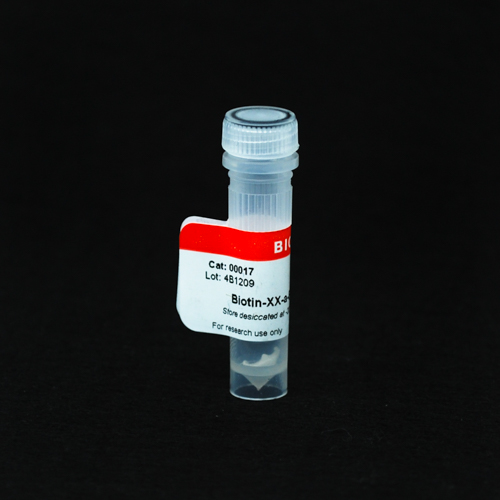Biotin-XX-α-Bungarotoxin
A high affinity inhibitor of the nicotinic acetylcholine receptor in the neuromuscular junction. Blocks acetylcholine activity at the postsynaptic membrane. The biotin conjugate can be subsequently labeled with anti-biotin antibodies, avidin, or streptavidin for signal amplification.
Please fill in the inquiry form and we will contact you shortly.
Wishlist updated! View wishlist
Product Description
A potent neurotoxin that is an inhibitor for the motor endplate acetylcholine receptor (Kd = 1 nM to 1 pM). It binds at the neuromuscular junction with high affinity and is often used to study neuromuscular junctions by blocking cholinergic receptors. The toxin also blocks α7 receptors, located in the central and peripheral nervous systems. The biotin conjugate can be subsequently labeled with anti-biotin antibodies, avidin, or streptavidin for signal amplification.
- A polypeptide snake toxin
- Blocks and inhibits cholinergic receptors
- Biotinylated for avidin or streptavidin reactivity and signal amplification
- White solid soluble in water
Biotinylated α-bungarotoxin is useful in the affinity column isolation of the nicotinic AChR using an avidin or streptavidin agarose (1). Nicotinic AChR labeled with biotin-XX-α-bungarotoxin can be localized using enzyme or fluorophore-labeled conjugates of avidin or streptavidin (2,3). Alpha-bungarotoxin may also be used for detection of GABA A receptor subsets in cells (4), or for labeling recombinant proteins that express the alpha-bungarotoxin binding site (BBS) epitope tag (5).
We also offer unlabeled α-bungarotoxin and CF® Dye α-Bungarotoxin conjugated to our next-generation fluorescent dyes. See our complete selection of α-Bungarotoxin Products below.
α-Bungarotoxin, CF® Dye and Other Conjugates
| Conjugation | Ex/Em | Size | Catalog No. | Dye Features |
|---|---|---|---|---|
| Unconjugated | N/A | 1 mg | 00010-1 | |
| Biotin-XX | N/A | 0.5 mg | 00017 | |
| CF®405S | 411/431 nm | 100 ug | 00002-100ug | CF®405S Features |
| 0.5 mg | 00002 | |||
| CF®488A | 490/516 nm | 100 ug | 00005-100ug | CF®488A Features |
| 0.5 mg | 00005 | |||
| CF®543 | 543/563 nm | 100 ug | 00026-100ug | CF®543 Features |
| 0.5 mg | 00026 | |||
| CF®555 | 554/568 nm | 100 ug | 00018-100ug | CF®555 Features |
| 0.5 mg | 00018 | |||
| CF®568 | 562/584 nm | 100 ug | 00006-100ug | CF®568 Features |
| 0.5 mg | 00006 | |||
| CF®594 | 593/615 nm | 100 ug | 00007-100ug | CF®594 Features |
| 0.5 mg | 00007 | |||
| CF®633 | 629/650 nm | 100 ug | 00009-100ug | CF®633 Features |
| 0.5 mg | 00009 | |||
| CF®640R | 642/663 nm | 100 ug | 00004-100ug | CF®640R Features |
| 0.5 mg | 00004 | |||
| CF®680R | 680/701 nm | 100 ug | 00003-100ug | CF®680R Features |
| 0.5 mg | 00003 | |||
| Fluorescein (FITC) | 498/517 nm | 0.5 mg | 00011 | |
| 10 x 50 ug | 00013 | |||
| Tetramethylrhodamine (TRITC) | 552/578 nm | 0.5 mg | 00012 | |
| 10 x 50 ug | 00014 | |||
| Sulforhodamine-101 (Texas Red®) | 595/613 nm | 0.5 mg | 00015 | |
| 10 x 50 ug | 00016 |
References
- PLoS One, 8, 7, (2013), DOI: 10.1371/journal.pone.0070338
- Am J of Pathol, 177, 2509 (2010), DOI: 10.2353/ajpath.2010.100243
- Cell Tissue Biol, 4, 258, (2010), DOI: 10.1134/S1990519X10030077
- PNAS, 103, 13, (2006), DOI: 10.1073/pnas.0600847103
- Meth. Enzymol., 521, (2013), DOI: 10.1016/B978-0-12-391862-8.00006-5
- Neuroscience, 174, 234, (2009), DOI: 10.1016/j.neuroscience.2010.11.016
- J Cell Biol, 150, 1385, (2000), DOI: 10.1083/jcb.150.6.1385
- Neuron, 23, 675, (1999), DOI: 10.1016/s0896-6273(01)80027-1
- Neuron, 12, 167, (1994), DOI: 10.1016/0896-6273(94)90161-9
- J Cell Biol, 125, 661, (1994), DOI: 10.1083/jcb.125.3.661
- J Biol Chem, 268, 25108, (1993), PMID: 8227074
- Muscle Nerve, 5, 140, (1982), DOI: 10.1002/mus.880050211
- PNAS 77, 4823, (1980), DOI: 10.1073/pnas.77.8.4823
- Science, 196, 540, (1977), DOI: 10.1126/science.850796

